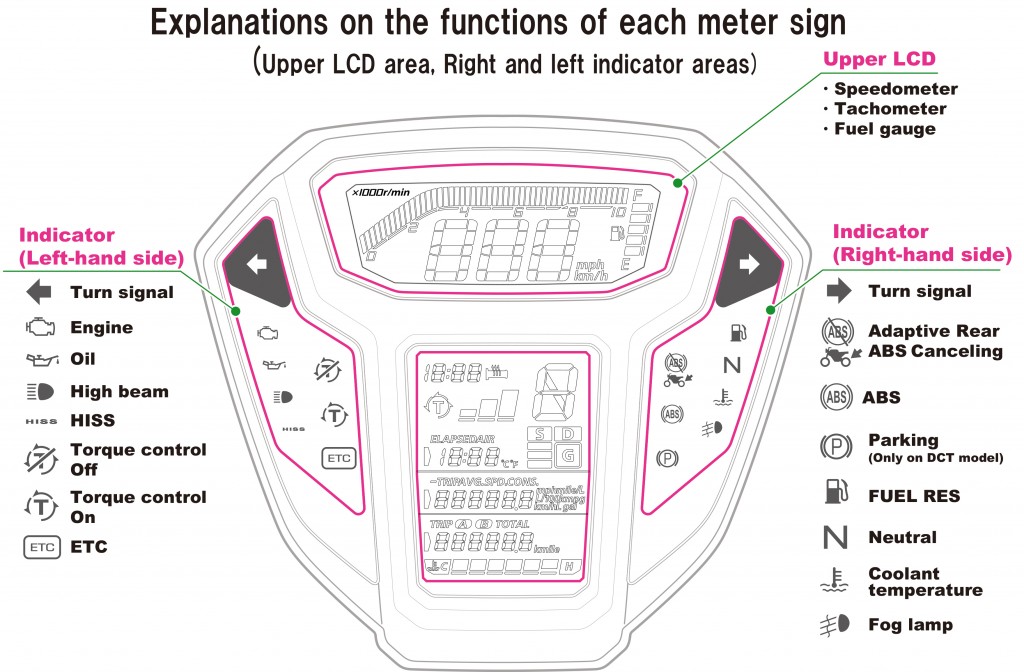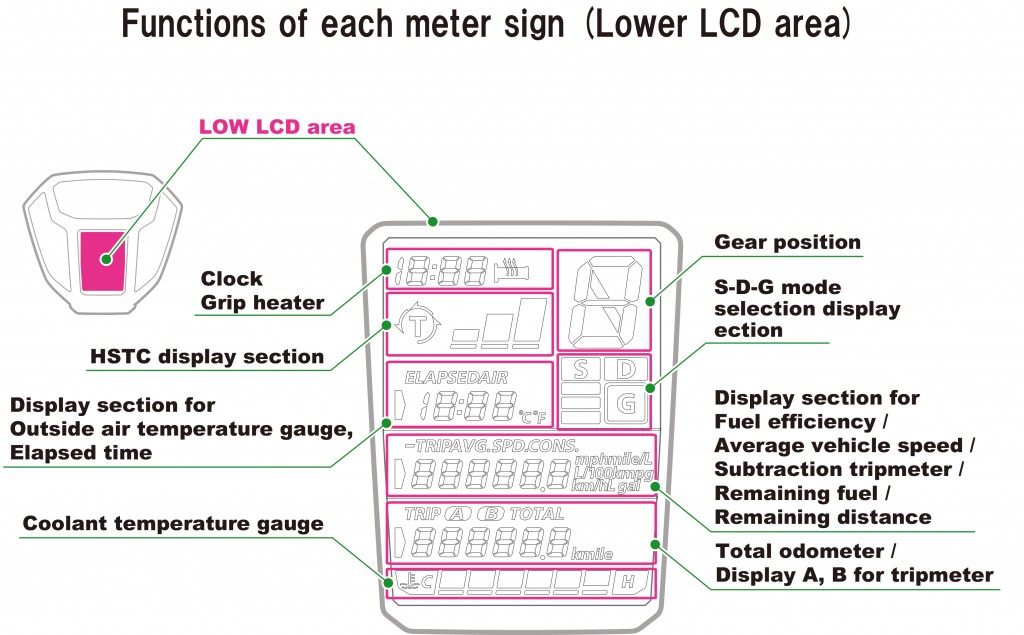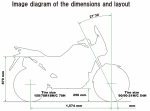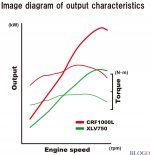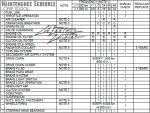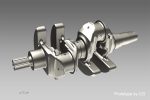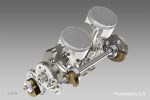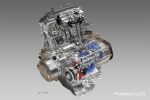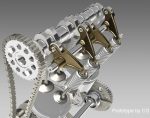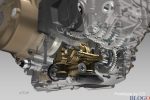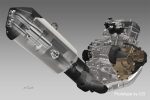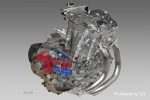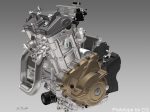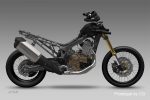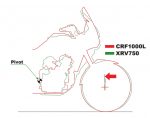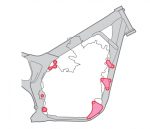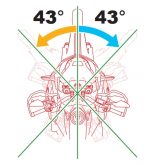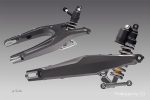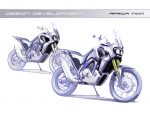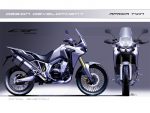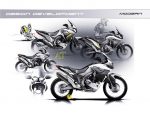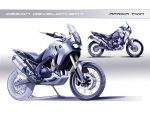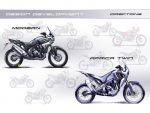– Detailed 2018 – 2016 Honda Africa Twin CRF 1000 Engine / Frame & Chassis / Suspension / Electronics Overview –
It’s time for another new Africa Twin 1000 UPDATE! Are you one of the unlucky guys in the USA that hasn’t gotten a chance to look at the Africa Twin in person yet? Still doing your research on whether or not this is the right adventure motorcycle for you in 2016? Here’s an update with some new information to help hold you over while you wait till the CRF1000L releases in your country…
- 》 2018 Africa Twin (CRF1000L) Review + NEW Changes – Click Here
- 》》 New 2018 Africa Twin ADVENTURE SPORTS (CRF1000L2) Review – Click Here
Debuting under the motto, ‘True Adventure,’ the new CRF1000L Africa Twin appears as a traditional Honda big off-roader for a new era. This all-new ‘Big Off-Roader’ package was created from scratch by an enthusiastic team of development engineers who love off-road riding. Staying one step ahead of everything else on the road, this uniquely ‘Honda-style’ off-road model embodies the true Spirit of Adventure.
Africa Twin History
Honda’s first-generation Africa Twin was released in 1988 as a large-displacement touring bike that played a central role in the creation of the Adventure Sports category. At the time, on-road super sports models were rapidly growing in popularity around the world, and the African Twin was conceptually very much the antithesis of those sports machines.
Its design roots could be found in the NXR750, the specially developed Honda Works rally machine that from 1986 took the title in the motorcycle division of the Paris-Dakar Rally (currently ‘Dakar Rally’) four years in a row in what is to this day regarded to be one of the most severe tests of man and equipment in the world. The technologies developed for this Honda factory racer were fed back directly into the development of the Africa Twin, making it a ‘racer replica’ of the famed off-road rally machine.
While market interest in large-displacement motorcycles produced in the late 1980s was largely focused on ‘racer replica’ super sports models, the Africa Twin’s positioning as a touring bike with off-road styling was, in a word, unique. Moreover, as most off-road models were powered by small to midsized engines, the Africa Twin’s large-displacement V-twin made it singularly extraordinary for its time.
Featuring distinctive off-road styling, the African Twin made its debut with a large-volume fuel tank, dual headlights and large integrated fairing. Its liquid-cooled 4-stroke 52° V-twin engine featured Honda’s unique offset dual-pin crankshaft for smooth operation, a 3-valve head configuration for enhanced intake and exhaust efficiency, and dual spark plugs for improved combustion efficiency. As a road bike, the Africa Twin’s highly reliable power unit also made it an excellent touring model for its time.
The African Twin’s chassis was constructed on a highly rigid box-section double-cradle frame, and featured a large-volume 24-liter fuel tank that integrated in form with its wide-coverage fairing. Fitting an off-road styled model with such a large fairing gave this ‘Paris-Dakar Replica’ the look of the actual machines that had recently conquered the Paris-Dakar Rally. Further equipping it with dual headlights and a large aluminum engine bash plate, not to mention wide-coverage knuckleguards, rugged front fork bottom case covers and a spacious buckskin-textured seat, gave birth to a new Rally Replica genre of Dual Sport motorcycles that had never existed before.
In 1990, the Africa Twin’s displacement was increased from 647cc to 742cc. It was also given a larger and taller windscreen, a larger-capacity battery, and brighter headlights, which further augmented its broad appeal as a full-scale Adventure Sports model. 1992 saw the adoption of a multi-function digital trip meter, which provided not only dual odometers and a trip countdown display function, but also a stopwatch. A full model change in 1993 further raised the Africa Twin’s level of refinement, and extended its popularity as a full-sized Adventure Sports model well beyond the end of its production run in 2003.
The New Africa Twin Emerges at Last
The Africa Twin, a legendary machine of which Honda has long been extremely proud, and a pioneer of the Adventure Tourer category of large-displacement dual sport motorcycles, is making its return. Impassioned requests from enthusiastic fans around the world have finally borne fruit nearly 15 years after production of its predecessor model came to an end.
The passion with which a small group of young engineers kept alive the dream of creating a new big off-roader, an Adventure Tourer, gradually expanded, resulting in the rebirth of the new Africa Twin.
The new African Twin they eagerly sought to create would maintain its predecessor’s fundamental concepts while being infused with the best of over 25 years of accumulated state-of-the-art technology. A full-cowl touring model powered by a large-displacement engine that is also capable of freely venturing well off the well-traveled road — this concept has now been revived and given new form. A well-rounded machine that expert development engineers finished with the passions of young engineers in mind. Completed with a wide range of riders in mind, from relative novices to adventure experts, and from touring aficionados to off-road fans — This is the new Africa Twin.
This new Adventure Tourer is powered by a newly developed liquid-cooled SOHC Unicam 4-valve parallel-twin engine. Although the original Africa Twin was known for its V-twin engine, one reason that the new Twin does not employ the same design configuration is that an engine type that best matched the machine’s new compact proportions needed to be selected. The engine’s forward-canted parallel-twin layout helps realize a shorter longitudinal length than possible with V configurations, further making it possible to shorten the overall length of the chassis and its wheelbase. Also, relative to the V engine, this compact twin further offers the merits of centralized mass for more responsive handling, and a slimmer shape in the seat area.
The 998cc engine’s output of 93.8 HP / 70 kW was determined to be more than sufficient for both long touring and off-road adventures. This also allowed the chassis to be designed for lighter weight and more compact proportions, as well as offering easy control. Further, its 270-degree offset crankshaft provides excellent traction from low in its rev range, and strong, responsive acceleration, delivering up a pulsating engine feel that only an irregular combustion interval can provide.
Additionally, the Honda Selectable Torque Control System (HSTC) is offered as standard equipment. This electronic control system controls the amount of engine torque reaching the rear wheel in order to minimize slippage and wheel spin, and maintain an appropriate posture while riding. This control system can also be manually disabled during sport riding, and can be said to be symbolic of the importance attached to the Africa Twin’s off-road riding capabilities. Moreover, the Twin’s switchable Antilock Brake System (ABS) makes it possible to disable only the rear tire’s ABS function, providing an extra degree of freedom and flexibility during off-road rides. In other words, the new Africa Twin is a riding machine that attaches the utmost importance to total mobility during off-road travels.
Another notable feature is a version being released equipped with Honda’s unique Dual Clutch Transmission (DCT). Till now, DCT had been designed to provide greater comfort and ease during long rides. However, besides its obvious benefits during high-speed touring, it was specially adapted to the Africa Twin with off-road use in mind. Because of this, a ‘G Switch’ was added, which enables the capacity of the clutch to more closely conform with engine torque output whenever momentary increases in traction are needed when travelling off-road. This can also be disabled whenever a more gentle application of the clutch at low revs is preferred, enabling the rider to gain a more visceral feeling of the engine’s power, depending on riding conditions. Additionally, a hill climb/descent detection function has also been added, allowing appropriate speed adjustments when travelling up and down steep hills.
Although the Africa Twin’s vehicle weight is virtually the same as that of its famed predecessor, in the quest for more effectively centralized mass, weight distribution was calculated to provide more responsive controllability, better enabling it to confidently venture off road, even though it is at its heart it is a large-displacement touring model.
The Africa Twin’s styling was designed with an emphasis on providing a slim and lightweight feel while offering a sense of substantial volume. Its bodywork features an integrated form free of bulging protrusions that helps minimize damage in the event of a fall while riding over rough roads.
A young team of development engineers contemplated what an Adventure Tourer of the future should be, and succeeded in making the new Africa Twin a motorcycle that tempts riders to explore new roads and lands off the beaten path, whether riding tandem or fully loaded with touring luggage.
Adventure does not necessarily mean only charging out across undeveloped lands or deserts. Venturing off onto an unexplored side road for the first time can also be an adventure – this machine enables its riders to actually experience such feelings. Welcome to the new Africa Twin, the ideal Adventure Tourer for a new age.
Africa Twin Technical Points
The more one comes to know about the new Africa Twin, the more one can come to understand that it is a motorcycle featuring two ‘exceptionalities.’
One is that it features superb off-road performance, although it is fundamentally a large-displacement touring bike, and the other is that it powered by a large-displacement engine in spite of it being an off-road bike.
Usually, off-road motorcycles become harder to control as their engine displacement increases, and comfortable touring bikes often require a certain increased degree of displacement and weight.
The Africa Twin was created with these points in mind.
Unlike the venerable V-twin engine that most people associate with the original Africa Twin, the new Africa Twin’s engine features a compact parallel-twin configuration. To improve controllability and handling ease when riding off-road, the distance between the rider and the front wheel needed to be shortened. It is for this reason that the parallel-twin engine, which is shorter in longitudinal length than the V-twin, was selected. The adoption of the parallel-twin engine also offers additional merits in that it allows the center of gravity and mass of the engine to be positioned farther forward than is possible in the case of the V-twin, leading to an optimal front load distribution.
On the other hand, off-road riding requires the ability to freely change one’s riding position, and so the rear end of the fuel tank where it integrates with the riding position and around the seat rails needs to be made as narrow as possible. Although the rear cylinder of a typical V-twin engine may be located between the rider’s thighs when ridden, if a parallel-twin engine is used, that area can be put to more efficient use as a space for auxiliary equipment, etc. Because of this merit (i.e. the ability of providing more centralized mass by positioning the heaviest components, such as the battery, in that space), the parallel-twin configuration proved to be essential. For this reason, it can be said that Honda gave priority to the design of the engine without tying itself to the conventional image of the Africa Twin.
Furthermore, as nearly 15 years had passed since the original Africa Twin ended production, technologies that made great advances in the interim were also selected for use in the new model. These include an ABS version, not to mention standard-equipped HSTC (Honda Selectable Torque Control). Honda’s advanced DCT (Dual Clutch Transmission) technology also proved to be effective for enhancing the off-road performance of this large-displacement touring bike.
The new Africa Twin is poised show us the brilliant new world that lies beyond the door to Adventure.
Package
The new Africa Twin maintains essentially the same body size and weight as its predecessor, however power output has been increased by fully 1.5 times. It is also 94 lb / 43kg lighter in weight than the VFR1200X, and 28 lb / 13kg lighter than the VFR800X. Moreover, its 93 HP / 70 kW power output is comparable to the 99 HP / 74kW put out by the CB1300 Series, enabling riders to fully enjoy its high power and torque, which rumbles up from deep down in its wide rev range, making the new Africa Twin a remarkably easy to control riding machine.
Furthermore, the Africa Twin also employs many technologies first introduced on the CRF450 Rally that recently competed in the Dakar Rally, such as an LED headlight that has proven to be highly effective for long touring, a multi-function meter and adjustable front and rear suspensions. These technologies combine with versions available with switch-selectable DCT and ABS to make the Africa Twin eminently suitable for a new era of motorcycling enjoyment.
Engine
The Africa Twin’s newly-designed parallel-twin engine employs a SOHC Unicam valve train to actuate the 4 valves in each combustion chamber. The engine’s compact configuration features an external design that doesn’t feel as if it has a large 1,000cc displacement. Power output characteristics offer excellent response, while its 270-degree offset crankshaft contributes to the engine’s enhanced torque and traction. Providing a pleasant pulsating feel, this engine offers excellent controllability, as if the throttle and rear tire were directly linked to each other. Further, as might be expected of a touring model, its engine provides strong torque from anywhere in its wide rev range, and features dual balancers for reduced primary vibration.
Handling
While the Africa Twin is a large-displacement touring model, its total weight does not exceed 511 lb / 232 kg (standard type: 502 lb / 228kg). Its chassis configuration has been finished to provide good controllability in off-road riding. Additionally, both front and rear overhangs are kept to a minimum, and the battery and other heavy components have been centrally positioned in the area nearest the motorcycle’s center of gravity for supremely agile handling.
Furthermore, the compact engine also makes possible a ground clearance height of 250mm, while also improving the Africa Twin’s stellar off-road performance.
Turning Capability
The Africa Twin’s 43 degree steering angle makes possible a minimum turning radius of 2.6m, which represents the top level in the adventure class. This feature also leads to improvements in turning ability not only when riding, but also when parking or moving the bike.
Two different seat heights (34.2 in / 870mm and 33.4 in / 850mm) can be selected by changing the seat’s mounting position. Further, a high seat and a low seat are also made available as optional equipment, with the former enabling the seat height to be raised by 30mm and the latter to lower the seat height by 30mm. This extends the highest seating position to up to 900mm and the lowest position down to 820mm, thus making it possible to adjust the seating position to best match a wide range of rider sizes.
Bodywork
As one would expect from a world-leading adventure model, the new Africa Twin features heavy-duty construction with bodywork and engine designed to be effectively free of protrusions in order to minimize the potential for chassis damage. The goal of this design is minimizing injury and damage that might occur if the motorcycle should accidentally fall when traveling off-road, etc. Moreover, some versions will also be standard-equipped with a large aluminum skidplate mounted under the engine.
And by minimizing the number of body panel parts used in the pursuit of functional beauty, a body construction that minimizes damage was realized.
HSTC (Honda Selectable Torque Control) System
The new Africa Twin also comes standard-equipped with the Honda Selectable Torque Control System, which controls the engine’s torque output by detecting differences in the slip ratio between front and rear wheels. When the rear tire loses traction on a slippery road surface, this system causes the control system to instantly kick in and suppress the torque generated by the engine by controlling fuel injection to inhibit rear tire slip. The amount of torque control can be selected in three steps, and the torque control system can also be disabled.
ABS-Equipped Version
The Africa Twin will also be made available in a version equipped with ABS (Antilock Brake System) and featuring mode switching capability. Called ‘Adaptive Rear ABS Cancelling,’ this system disables the ABS at the rear wheel when set to the OFF position. This feature contributes to off-road riding ease by allowing separate use of the front and rear brakes, allowing the machine to be controlled by only the rider’s operation.
DCT-Equipped Version
For the first time ever in an off-road model, the Africa Twin will also be made available in a version equipped with Honda’s innovative DCT (Dual Clutch Transmission) motorcycle technology. The system features both a Manual mode and two different automatic gear change modes: ‘D’ mode enables comfortable cruising and low fuel consumption, while ‘S’ mode offers a more sporty gear shift patterns (adjustable in 3 steps).
The system has also been equipped with a new ‘G Switch’ that allows the Africa Twin to control clutch application and power fluctuations at low revs, depending on riding conditions, for a perceptible increase in tractable power. Turning off the switch makes the power delivery more gentle, bringing an extra level of stability to the machine’s behavior.
The Africa Twin’s DCT was designed with the assumption that off-road riders needing to concentrate on the road or terrain ahead, not to mention their own body control, would greatly benefit from being relieved of the distraction of gear changes, making it possible to more fully enjoy the experience of off-road riding.
Africa Twin Development Story
Charging ahead with the passion of youth to create the ideal Africa Twin
A Dream Named ‘Adventure’
As Seen by a Young Team of Engineers
The ‘adventure’ spoken of by Thierry Sabine, founder of the Paris-Dakar Rally, has many different meanings, but motorcycles are always found in close proximity to this word ‘Adventure.’ “Adventure? Yes, I love it. Doesn’t every boy share a love of it? However, the adventure I’m talking about is not only one of trekking to the ends of the earth or visiting unexplored regions. Instead, adventure could entail such simple things as riding your bike off a well-travelled highway onto a small side road for the first time, or over a bumpy road,” says Yutaka Yamakura of Honda’s Motorcycle R&D Center, who was put in charge of the Africa Twin’s chassis and bodywork design. He talks cheerfully, with a big smile on his face, perhaps because he’s imagining riding a motorcycle, especially off-road. As a matter of fact, Yamakura is a ‘key man’ who played a vital role in the development of the new Africa Twin from its initial stage of development, creating its concept and determining its direction based on its predecessor model.
Back in high school, Yamakura had been fascinated by dreams of ‘adventure,’ as described by Paris-Dakar Rally founder Thierry Sabine.
Yamakura — “When I was in junior high school, the Paris-Dakar Rally was just starting to be televised. I watched that program many times, and the images I saw were absolutely riveting. There were many TV programs about the Paris-Dakar Rally, but mostly they focused on the cars in the competition. Instead, what I really wanted to see were the bikes racing in the ‘motocross division.’
“At first I was amazed to see them racing at top speed over such harsh terrain, thinking, “Wow! How can they race in a place like that on a bike?!” Soon, I began taking a deeper interest in the motorcycles themselves, and eventually learned about a bike called the NXR. It was a Honda Works machine, solely intended for racing in the Paris-Dakar Rally. As time went on, I became infatuated with the big off-road bikes, and even rode around on an Africa Twin that I’d bought myself when I was a university student. That was one of the reasons why I chose Honda as the company I wanted to work for.”
Wanting to Create a New Africa Twin
The Africa Twin was still in the Honda lineup when Yamakura joined the company. Holding out hope of someday making a new Africa Twin, and dreaming of taking charge of its development, Yamakura continuously talked about creating a new Africa Twin within the company. However, production of the Africa Twin ended only a few short years after he joined Honda.
Yamakura — “The end of the Africa Twin’s production left Honda with no large-displacement dual sport models in its lineup. From then on, I agitated for developing a new Africa Twin every chance I got.”
As a result of this personal campaign, when the development project for a new dual sport model finally began, Yamakura was selected as one of the team members. His chance had come at long last.
Riding Enduros on the Africa Twin.
Waves of Enthusiasm Begin to Grow.
As Yamakura speaks animatedly about the project, Akihiro Iida smiles quietly, like an older brother. Iida has long been deeply involved in engine development at Honda’s Motorcycle R&D Center.
Iida — “I was really eager to go racing when I first joined Honda. Frankly, what I really wanted to get into was F1. Although I’d ridden motorcycles back in my school days, I didn’t have any special preference for them. When I first joined the company, I was assigned to the motorcycle division, but I soon asked to be transferred to HRC (Honda Racing Corporation) because I still wanted to do something in racing. I was surprised and delighted when the company granted me that wish. Since then, I’ve been put in charge of the development of many different categories of engines.”
At HRC, Iida took charge of the design of such engines as air-cooled singles and advanced 4-stroke engines for Trials bikes, as well as race engines for the Suzuka 8 Hours World Endurance Championship and Moto GP machines. Having played a central engineering role in these creations, Iida was selected to join the development team for the new Africa Twin.
Iida — “I have no idea why I was assigned to the Africa Twin development team. When I joined the team, I had so little knowledge of what the Africa Twin was that I had to ask, ‘Africa Twin? Isn’t that some kind of big off-road model?'”
Yamakura explains the reason. “The team needed an engine design specialist who is capable of designing small and lightweight engines from scratch.”
As the leader in charge of the new machine’s overall chassis and body design, Yamakura called on Iida as an expert in engine development. Besides Iida, other ‘Big Off-Road’ enthusiasts were also recruited from within the company to focus their efforts on researching structural strength and riding stability issues. The new project started off with discussions about what the Africa Twin was, and what the new Africa Twin should be.
Next, as a representative of the development team, Yamakura started riding his own Africa Twin in the company’s in-house enduro races. Competing against other smaller displacement models such as the XR100, CRF250L and XR250, his big Africa Twin finished the races in style, impressively showing off its riding ease and confident control.
Yamakura — “I told the other team members I’d selected that, ‘This is the sort of bike we want to make. Isn’t it great?’ I’d like to think they all came away with a better understanding of the Africa Twin’s many great features. I explained, ‘Let’s recreate this using today’s technologies! If we do it now, we can make a new Africa Twin entirely from scratch, with no need to think about carrying over existing components.'”
Yamakura’s enthusiasm gradually began to spread to the others around him.
Slim and Lightweight,
Yet a Big Off-Roader With a Feeling of Volume
The first step in the development of the new model began with deciding on a rough silhouette. What sort of bike should be aimed for? What was its concept? The team discussed a wide range of important factors and their reasons for including them, and gradually these ideas came together to form a rough image.
Yamakura — “In its first stages of development, our new Africa Twin was good in terms of concept, which was that of a large-displacement off-road bike that could be easily ridden over dirt and mountain trails, while also being a big touring bike that could provide a comfortable ride over long distances. I wanted to focus all the new technologies we’d accumulated over the past 25 years on that concept in the creation of this new version of the Africa Twin.
“Since I myself was an owner of an original Africa Twin, I considered all the things I wanted to carry over and refine, as well as new features that I thought should be incorporated into the new model. Also, from an owner’s perspective, I thought it would be good if the new model could be ‘more like this, or that’ and of course those factors were also included in the development. We purchased another secondhand Africa Twin for development purposes, and every member of the team rode it extensively in order to raise our common consciousness.”
In the meantime, an interesting phenomenon was also taking place. One after another, team members were buying their own Africa Twins, and soon a remarkable total of seven of the bikes were gathered in this one group.
“I bought an Africa Twin on Yamakura’s suggestion. One reason was that since I was assigned to the job of designing the new Africa Twin, I thought I should first be armed with some first-hand knowledge about the merits of the old one. I figured that if I could more precisely understand the Africa Twin’s various features, I could better reflect them in the new machine’s development.”
This is Akihiro Komatsu, who was in charge of design at Honda’s Motorcycle R&D Center. Komatsu is 12 years older than Yamakura and Iida, and a brilliant, highly logical person. Smiling behind black-rimmed glasses, his sharp, experienced eyes seem able to see through everything. Put in charge of the Africa Twin’s overall design, Komatsu first set out to gather ideas from other designers about a new Africa Twin.
Komatsu — “I engaged designers in Japan, the United States and Europe in a sort of design competition, and asked each of them to sketch out their own ideas of how a new Africa Twin should look. What sort of direction should it take, what styling, what sense of volume? A lot of original ideas arose from this small group of designers. Still, what was particularly interesting was that nearly all were agreed on creating a large-displacement off-road model that’s lightweight and slim, yet still has a robust sense of volume. Going on that, the bike’s styling gradually began to take shape.”
Komatsu could sense the passion that both Yamakura and Iida radiated when talking about their dreams for the Africa Twin. As the development project gradually advanced from its initial stages, and the machine’s actual form slowly began to take shape, the younger engineers occasionally revealed their seemingly fantastic dreams.
Komatsu — “I thought it important not to disturb those dreams. Often, the ideals of the chassis and engine engineering departments conflict with those of the design department, so naturally I thought that this time the opinions of the designers should be restrained as much as possible to help the engineers’ dreams come true. I could feel that the Africa Twin was their dream, and that it was a bike that needed to be created from a strong sense of passion.”
As it turns out, Iida had the same idea.
Iida — “Yamakura’s enthusiasm and dreams for the new Africa Twin came to inspire more and more people around him. My feeling was that, as an engine designer, I couldn’t be selfish. First, Yamakura and the other engineers had their strong impressions of how the new Africa Twin should look, and any opinions about desired features presented themselves thereafter in a sort of common consciousness. As a result, my feeling was that we should design an engine that was best suited to the completed motorcycle.”
Normally, engineers make a point of giving an engine they’re designing a certain amount of flexibility, so that it can be used in possible future applications. When it comes to big dual sport models, there are often times when currently existing engines are considered for use, or an engine’s basic design and construction are appropriated for use in an on-road model at a later date. However, the team adamantly refused to reflect this thinking in the Africa Twin’s engine development. This engine must be designed solely for the new Africa Twin — otherwise their enthusiastic dreams might evaporate into thin air.
Iida — “As development continued, we reached the stage where Komatsu’s design was nearing completion and the space for the engine could roughly be seen. Once the motorcycle’s basic silhouette became visible, we could focus on creating an engine design based on a relatively fixed set of specifications. In this way the development plans began to take shape. Of course, at this point in time, we didn’t really care whether the engine was air-cooled or liquid-cooled, or had a single, twin or V4 configuration. Also, owing to the Africa Twin’s history and known qualities, we took a good look at the original V-twin configuration, but finally decided it best not to cling to the past in our engine selection.”
The original Africa Twin had long been synonymous with Honda’s most prominent large-displacement off-road models. Fundamentally, its size, volume and integrated cowling reminded people of the Paris-Dakar racing machines, which were also equipped with V-twin engines. However, in considering what was required of the new Africa Twin, attention paid to the optimal size, shape, weight and necessary specifications of the complete package helped the team find the best engine for the job, which turned out to be a parallel-twin engine rather than a variation on the original V-twin.
Not Only Touring Performance,
But Also Off-Road Capabilities.
Engine types must be selected depending on the attributes of the machines in which they’ll be mounted, as well as on their intended power characteristics. It is also important to bear in mind the size and weight of the engine relative to the space available in the chassis design, not to mention the product features.
Yamakura — “What we wanted above all else was a lightweight machine. Besides being slim and compact, models like this require a responsive feeling of front tire contact with the ground, and so it’s best to locate the front tire as close as possible to the rider, even if by only a millimeter or two. Moreover, since I wanted to simplify the design wherever possible and make the external design neat, I selected a parallel-twin engine design that is short in longitudinal length.”
Displacement was originally set at 1,000cc in view of the fact that this provides the best balance between needed output and lightweight and compact proportions. Strong output as well as physical size and weight that can be easily handled by anybody were also conditions required of the new Africa Twin.
Yamakura — “As an engine designer, I know it’s possible to attain power outputs of upwards of 200PS from a 1,000cc engine, however this would mean it would no longer be the Africa Twin we envisioned. So I decided that a 1,000cc parallel two cylinder configuration would offer the best balance. When taking overall controllability into consideration, I came to the conclusion that 70kW in output would provide the desired strong low-end torque and reduce power at higher revs.”
The earlier Africa Twin had employed a V-twin engine that at the time was regarded as ideal in terms of size, weight and power feel. However, current state-of-the-art technologies make possible more lightweight and compact construction, and a feeling of power that still provides a sense of being highly controllable, even with a 1,000cc parallel twin engine.
Iida — “V-twin engines can be quite difficult to fit into a motorcycle, particularly in regards to the positioning of the rear cylinder. If the rear cylinder is located there, it impairs the rider’s foot contact with the ground. I laid out the arrangement of the axes dozens of times before finally settling on a design plan.”
However, other problems arose. As the development phase approached the actual process of giving form to the engine, at the stage where specifications were nearly finalized and the the prototype was about to be made, a request was received from the design team for a modification.
Komatsu — “I didn’t intend to interfere in the designs of the chassis and engine, but there was just one area where things didn’t match up as I’d expected. Although it involved the shape of the engine, the first silhouette never did produce a sense of neatness and integration with the complete package. Even though it was only one small area that actually required modification, modifying a section that had already been finalized required a complete redesign of virtually everything all over again. I felt bad about making such a request, but eventually persuaded the rest of the team by reminding them that we couldn’t compromise our dreams for the new Africa Twin.”
In line with the Africa Twin’s desired attributes, engine characteristics needed to be made compatible with off-road performance, not to mention the desired touring performance, and both brought into a high degree of balance. Good touring performance requires a comfortable feeling of power that can be easily accessed over even long rides, while good off-road performance should provide both excellent traction over unpaved roads and a noticeable sensation of the engine’s power pulses.
Iida — “So, assuming the original Africa Twin to be a rival of sorts, I thought that the new version should have more tractive performance, a torqueier delivery from lower in its rev range, and a pulsating feel as revs increase. As a result of extensive research, what we settled on was a 270 degree offset crankshaft. This irregular combustion interval provides the tractive performance we were looking for, as well as a pulsating feel while also effectively cancelling out secondary vibration. I figured that we could achieve the desired results by merely installing a balancer to reduce primary vibration.”
The structure of the chassis in which this new-generation engine would be installed was determined in a fairly orthodox manner based on the policy of maintaining the Africa Twin’s highly appraised strong points without showing off its originality. One reason was that if even the chassis is also made new because the engine was replaced with the latest generation available, it would be virtually impossible to ensure the reliability and durability required of the adventure touring model.
Yamakura — “Using the original Africa Twin’s chassis and body design as a reference, we tried to keep its basic concept, but we also needed to retain the Africa Twin’s good handling and operating ease, as well as its other highly regarded assets. Our goal was to create a form that was equal to its predecessor in size, yet offering one-and-a-half times the output combined with a lighter vehicle weight, even if only by a single gram, and which gives the impression of being imposing yet even-tempered when ridden. I felt that this size would be good for expressing the Africa Twin’s ruggedness, dependability and manageable nature.”
Development had reached the point where the prototype was just on the verge of its first actual road test. The number of test members had also increased, allowing the project to begin to proceed to the commercial production planning stage, where the new model could be run on a larger scale.
A Big Touring Bike
With Stronger Off-Road Performance
“That’s when I rode it for the first time. It was still a prototype, and though I wasn’t a member of the development team, I was asked to give it a ride and provide some commentary. My honest, immediate reaction was that what they were making was not what they set out to create.”
This is Tetsuya Kudō, who in years past had taken charge of the development of such legendary Honda motorcycles as the RC30, the NR750, the CB1300 series and the CB1100 at Honda’s Motorcycle R&D Center. Kudō is not only an engineer who has designed many well-known motorcycles, he is also an avid motorcycle rider who loves touring with his own 250cc off-road bike. Naturally, his opinions tend to be insightful.
Kudō — “I knew that their team was developing the new Africa Twin. However, when I rode the prototype, what I actually felt was vastly different from what I had heard and expected. It hardly seemed to stray very far from the touring bike category, or at least I didn’t feel any of the off-road performance they were telling me about. ‘What on earth are they trying to achieve here? This isn’t the bike they’re aiming for, is it?’ Its shape was nearly complete, but its contents were still a long way away from their original image.”
Kudō conducted several test rides of both the original Africa Twin and rival models in the Adventure class, and took them touring over and over again. In fact, for a few months he rode them almost every weekend. Soon thereafter, Kudō also officially joined the development team as its overall coor-dinator in order to guide the direction of development and give the new machine some ‘flavor’ in its final stages.
Kudō — “Anyway, I thought I’d try to ‘season’ the bike’s off-road performance. This is usually a matter of seasoning the engine, but first I wanted a lot more of the feeling of the tires gripping the ground, and intensely concentrated on that one point. In my view, this machine’s virtual rival would be a 250cc class bike. The ability to, on a whim, cut off onto a dirt side road you spot while touring on a national highway can be achieved by seasoning the engine or using the chassis’ controllability, because that was certainly possible with the original Africa Twin.”
As he repeated the process of giving the engine more ‘flavor,’ reviewing the chassis and resetting the suspension over and over again, Kudō gradually began to sense that the new Africa Twin was finally starting to take shape from its first prototype.
Kudō — “Since the specifications of the first selected engine and chassis were so good to begin with, they could be increasingly improved through repeated seasoning. In particular, I felt that the new DCT (Dual Clutch Transmission) could give it some extra unexpected appeal. Even I was able to do things on this bike that I’d never experienced before.”
DCT is a technology of which Honda is most proud. Of course, one aspect is that it makes riding easy, as one would want in touring performance, but its characteristics were retuned to best fit the new Africa Twin as an effective mechanism for enhancing off-road performance.
Kudō — “For example, when venturing off road, sometimes the ground is more rugged and uneven than expected, or big holes continually turn up. At such times this usually requires a precise combination of throttle and clutch work while shifting up and down through the gears, and body control to keep your balance in low gear. In these situations, the DCT proved to be surprisingly effective. It allows the bike to run smoothly and easily, and is especially effective when traveling slowly at low speeds. Wanting a more solid feel of the tires gripping the road surface in such cases, I flipped on the G switch*.”
* The G switch is a new function added to the DCT that gives the clutch more capacity to control the engine’s torque. It can better transmit that torque to instantly enable the rear tire to grip the road surface. Leaving the switch off makes it possible to respond to such conditions much like gently letting out the clutch at low revs.
The new Africa Twin was moving toward completion at last. However, reality waits for no one. Counting back from the announced release date set when model development began, very little time remained.
“I joined the development team around that time. It was a stage at which development was proceeding, but much more needed to be done, including the actual production in preparation for sales. I already knew what they were doing, and therefore my role was to closely keep an eye on the reality of the situation by getting favorite aspects and desires into shape,” says Naoshi Iizuka who served as a Project Leader. Iizuka, who is a contemporary of Kudō’s at Honda, is also an expert engineer and has handled many of the company’s best-known machines of years past, as Kudō has. It becomes Iizuka’s duty to get the project into gear.
“Since I joined the team, I’ve worked almost every day without taking any days off.”
Iizuka smiles,
“Every day has been non-stop rushing about the whole time.”
Development continued forward toward the final stage.
This Machine Not Only Takes You On Adventures,
It Also Makes You Feel Like Setting Out On New Adventures
Iizuka — “Certainly, model development is a job devoted to making things. However, in order to sell a model as an industrial product, a lot of work needs to be done besides the manufacturing. Since the development of the new Africa Twin was started and spurred on by the enthusiasm of a group of young engineers, I wanted to give their passion and enthusiasm the respect they deserved. However, since they were also under pressure that takes form as a battle against time, I figured it was my role to absorb that pressure as best I could.
“For example, even though model development might be proceeding, before sales of the machine as a mass-produced product can take place, the process of manufacturing is waiting ahead. In order to manufacture the product, materials must be secured and costs calculated with production in mind. You can’t get away with saying you’ve designed the model you want, but not know how much it costs.
“I joined this project with the idea that I would give the opinions of the development team the utmost respect, but that they should also keep in mind the issues of cost and production schedules, and do their best not to affect them. However, the more I got to know the details of this bike, the more excited I felt about the new Africa Twin. Around the time I first joined Honda, my senior colleagues were all involved in the original Africa Twin’s development. So, I was eager to help this new Africa Twin attract the world’s attention as a machine that can live up to the excellent reputation of the Africa Twin they first created.”
The project that was sparked by the enthusiasm of this team of young engineers quickly approached completion through the determination of its director and the support of its coordinator. By this time, a new adventure tourer that could thrill even such a wisecracking person as Kudō had already been completed.
Yamakura — “Although we weren’t doing as we pleased, when Kudō and Iizuka joined us, the new Africa Twin suddenly became a lot more realistic. The bike’s character was determined with a simple process of tuning and seasoning, without significantly changing the basic production factors we were hoping to achieve, and soon the production schedule loomed into view. The new Africa Twin changed from a vision of something ‘I want to build’ to a model that ‘we’re building,’ and then became an actual product in which ‘all our desires are invested’ that had evolved quite a lot from the image we first had when we started.”
Kudō — “The resulting machine was finished to such a high degree that it can cruise comfortably on any highway, even riding double or carrying sidebags loaded with clothes and equipment. We were able to provide it with an easy-to-control chassis capable of traveling comfortably even on congested roads and easily negotiating U-turns in a small supermarket parking lot, while also giving it easy-to-handle engine characteristics. My feeling is that this is really the bike they wanted to make. Come to think of it, the earlier Africa Twin shares many similarities in that regard.”
If touring bikes offering off-road performance fall into the Adventure Touring category, then the adventures that Iizuka imagines are even more concrete.
Iizuka — “I don’t really care if it’s never ridden on the dirt. I wanted to make it a bike that can thrill riders with a feeling of expectation. Of course it has the ability to travel over rugged dirt roads with ease, whenever and wherever those roads are encountered. This is important, I think, even if it’s never actually ridden on an uneven road. I want to make riders feel like they could travel down rough dirt roads, and want them to experience that sort of riding with complete satisfaction.”
Yamakura — “This really is an adventure, isn’t it? Still, as Iizuka said, one’s definition of adventure differs from person to person, so if our new Africa Twin can get people to think about having an adventure, going on a trip or riding off-road, then I think you could say we’ve succeeded in achieving the aims we had when we set out to create this machine.”
Iida — “I want riders to visit places they’ve never travelled to before, even if only venturing onto a side road just off the streets they regularly ride.”
Komatsu — “When I started working on this project, I changed over from the Varadero I’d been riding to an original Africa Twin. However, now I want to switch to the new Africa Twin just as soon as I can. I haven’t yet told my wife how much it will cost, so I can’t help wondering if I can get her approval.”
Kudō — “I plan to buy one, too. I currently ride a CB1000R, and though I have strong feelings for that streetfighter, riding the new Africa Twin I can cover any sort of riding I want to do with a single machine.
“I want one, too, but I’m afraid my legs are too short to reach the ground,” says Iizuka, and Yamakura responds with a smile, “No problem, we’ll set you up with an optional lower seat.”
Sabine once said he could show us the ‘Door to Adventure. ‘Now, the Africa Twin is poised to take riders beyond the ‘Door’ that was first opened.







